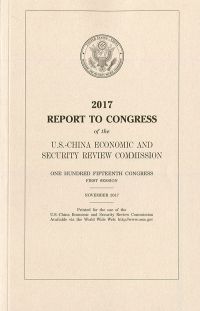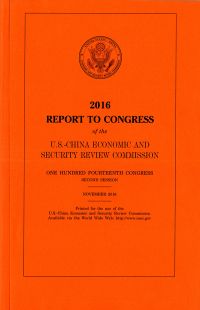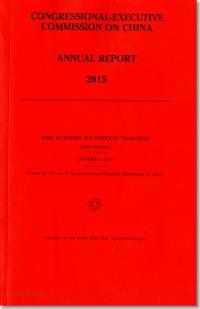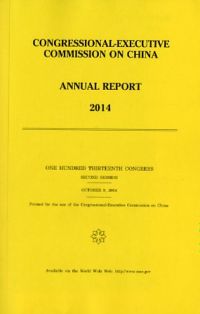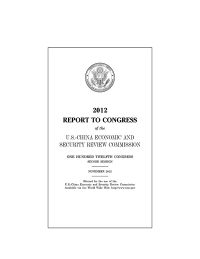
In 2019, the trade dispute between the United States and China entered its second year and remains mostly unresolved. The Chinese government’s unwavering commitment to state management of its economy remains a major stumbling block. In response to decades of unfair economic practices, the United States wants the Chinese government to codify commitments to strengthen intellectual property protection, prohibit forced technology transfer, and remove industrial subsidies. But these practices are core features of China’s economic system, and the Chinese government views U.S. demands as an attack on its national development. China continues to ignore the letter and the spirit of its World Trade Organization (WTO) commitments. The resulting impasse has led to multiple rounds of mutual tariff actions impacting more than $500 billion in bilateral goods trade, and reducing trade between the two countries.
Transmittal Letter to the Congress iii
Commissioners Approving the Report v
Executive Summary 1
Key Recommendations 24
Introduction 29
2019 Report to Congress of the U.S.-China Economic and Security Review Commission Chapter 1: 2019 in Review 33
Section 1: Year in Review: Economics and Trade 33
Key Findings 33
Introduction 34
U.S.-China Trade 34
Bilateral Economic Tensions 38
Technological Conflict and Competition 46
China’s Internal and External Economic Management 49
Section 2: Year in Review: Security, Politics, and Foreign Affairs 80
Key Findings 80
Introduction 81
A Year of Both Success and Setback 81
Chinese Diplomacy: Toward a China-Led World Order 89
Pressure on the Regional Balance 100
Tensions in U.S.-China Ties 104
Chapter 2: Beijing’s Internal and External Challenges 119
Key Findings119
Recommendations 120
Introduction 120
Internal Challenges to CCP Rule 121
China’s Economic and Innovation Challenges 130
Resistance to Beijing’s Ambitions Abroad: Economic, Military, and Political Challenges 136
Implications for the United States153
Chapter 3: U.S.-China Competition 169
Section 1: U.S.-China Commercial Relations 169
Key Findings 169
Recommendations 170
Introduction 171
U.S.-China Economic Ties: An Unbalanced Relationship 171
Chinese Companies in the United States 172
U.S. Companies in China 182
Implications for the United States 191
Section 2: Emerging Technologies and Military-Civil Fusion: Artificial Intelligence, New Materials, and New Energy 205
Key Findings 205
Recommendations 206
Introduction 207
VIII Page Military-Civil Fusion214
New and Advanced Materials 220
Energy Storage 226
Civil Nuclear Powers 229
Implications for the United States 230
Section 3: Growing U.S. Reliance on China’s Biotech and Pharmaceutical Products. 248
Key Findings 248
Recommendations 249
Introduction 250
U.S. Reliance on Chinese Pharmaceutical and Medical Products 251
U.S. Government Oversight of Health Imports from China 257
China’s Pharmaceutical and Biotech Activities in the United States 261
U.S. Companies’ Access to Health Industries and Market Opportunities in China 265
U.S.-China Global Health Cooperation 269
Implications for the United States 269
Chapter 4: China’s Global Ambitions 283
Section 1: Beijing’s “World-Class” Military Goal 283
Key Findings 283
Recommendations 285
A Military to Match Beijing’s Ambitions. 285
Building a World-Class Military 288
A World-Class Military in Its Region and Beyond 296
Implications for the United States 303
Section 2: An Uneasy Entente: China- Russia Relations in a New Era of Strategic Competition with the United States .315
Key Findings 315
Recommendations 316
Introduction .316
A Deepening Entente 317
Mistrust and Power Asymmetry Limit Ties 327
Central Asia and Afghanistan, the Middle East, and the Arctic. 335
Implications for the United States 343
Section 3: China’s Ambitions in Space: Contesting the Final Frontier 359
Key Findings 359
Recommendations 360
Introduction 361
National Rejuvenation and a “Space Dream” 362
Space Program Supports Geopolitical and Economic Goals 368
Space as the “Commanding Heights” of Future Military Conflict 379
Implications for the United States .383
Section 4: Changing Regional Dynamics: Oceania and Singapore 401
Key Findings 401
Recommendations 402
Introduction 402
Australia 403
Pacific Islands 418
Singapore. 424
Implications for the United States 431
Chapter 5: Taiwan. 445
Key Findings 445
Recommendations 446
Introduction 447
Cross-Strait Military and Security Issues 449
Taiwan’s External Relations 458
Economics and Trade 463
Implications for the United States 470
IX Page Chapter 6: Hong Kong . 481
Key Findings 481
Recommendations 482
Introduction .483
Proposed Extradition Bill Galvanizes Calls for Democracy 484
Hong Kong’s Autonomy under Continued Attack 496
Hong Kong’s Economic Relationship with Mainland China 505
Implications for the United States. 513
Comprehensive List of the Commission’s Recommendations 537
Appendices: Appendix I: Charter . 547
Appendix II: Background of Commissioners 555
Appendix III: Public Hearings of the Commission During 2019 565
Appendix IIIA: List of Witnesses Testifying Before the Commission During 2019 569
Appendix IV: List of Research Material 573
Appendix V: Conflict of Interest and Lobbying Disclosure Reporting 577
Appendix VI: Acronyms and Abbreviations 579
2019 Commission Staff and Acknowledgements 581
Product Details
- China
- Annual Reports, U.S.-China Economic and Security Review Commission


